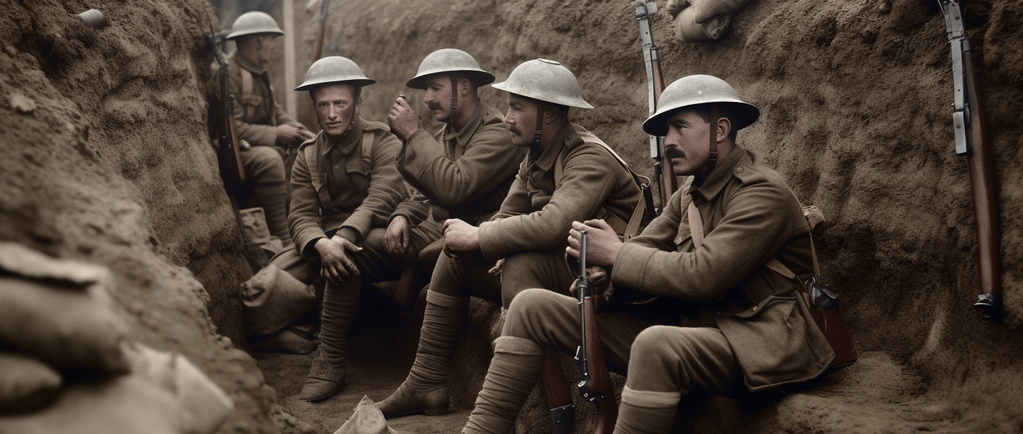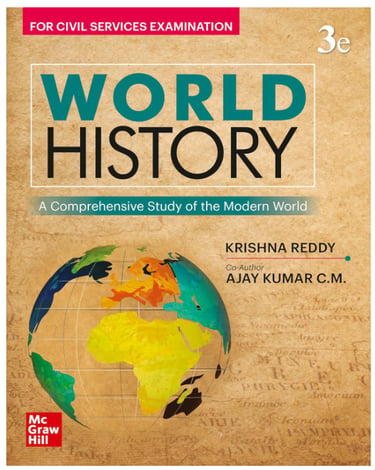The World War 1: A Comprehensive Overview
In this article we shall cover in-depth one of the important topics in General Studies Paper 1 of Mains Examination - World War 1. The article covers the causes, significant events and consequences of the war.
WORLD HISTORY


Introduction
World War I, also known as the Great War, was one of the most transformative events in modern history. It took place between July 28, 1914, and November 11, 1918, involving many of the world’s great powers at the time. This global conflict changed the geopolitical landscape of the 20th century, ushered in new forms of warfare, and set the stage for World War II. The war was primarily fought in Europe, but its impact was felt across Asia, Africa, and the Middle East. It resulted in the fall of empires, redrawing of borders, and the emergence of new ideologies and global power structures.
Causes of World War I
The causes of World War I were complex and interwoven, consisting of long-standing rivalries between European powers, nationalism, and militarism. The key causes include:
1. Alliance System: By the early 20th century, Europe was divided into two hostile alliances. The Triple Entente, which included France, Russia, and Britain, was pitted against the Triple Alliance, comprising Germany, Austria-Hungary, and Italy. These alliances were intended for mutual protection but increased the likelihood of a regional conflict escalating into a global war.
2. Nationalism: Nationalistic fervor had grown in Europe in the 19th and early 20th centuries. Nations sought to assert their dominance or independence, leading to tensions, particularly in the Balkans where Slavic nations were seeking freedom from Austro-Hungarian rule.
3. Militarism: European nations engaged in a massive arms race in the years leading up to the war. Germany and Britain competed in naval build-up, while most of the European powers expanded their armies. This militarization heightened the belief that war was inevitable and even desirable as a means of settling disputes.
4. Imperialism: Rivalries over colonial possessions exacerbated tensions. European powers like Britain, France, and Germany competed for control over Africa, Asia, and the Middle East, leading to diplomatic confrontations.
5. Assassination of Archduke Franz Ferdinand: The immediate spark that ignited the war was the assassination of the Austro-Hungarian heir, Archduke Franz Ferdinand, by a Serbian nationalist in Sarajevo on June 28, 1914. Austria-Hungary, backed by Germany, issued an ultimatum to Serbia, leading to declarations of war between the alliance systems.
The Course of the War
The war unfolded in several phases, each characterized by different strategies and key battles:
1. 1914: Outbreak and Early Battles
After Austria-Hungary declared war on Serbia, Russia mobilized to support Serbia. Germany declared war on Russia and France, and Britain entered the war to defend Belgium’s neutrality.
The war quickly became a stalemate as both sides dug into trench warfare, particularly on the Western Front. The Schlieffen Plan, Germany's strategy to quickly defeat France before turning on Russia, failed as they were stopped at the Battle of the Marne in September 1914.
2. 1915–1916: Trench Warfare and Stalemate
The Western Front saw horrific trench warfare, with soldiers living in miserable conditions while enduring artillery bombardments, poison gas attacks, and infantry charges across "no man's land."
The Eastern Front saw more movement, with Russia initially pushing into Austria-Hungary before suffering major defeats at battles like Tannenberg.
By 1916, massive offensives like the Battle of Verdun and the Battle of the Somme resulted in millions of casualties but little territorial gain.
3. 1917: Turning Points
The war expanded as the Ottoman Empire and Bulgaria joined the Central Powers, and Japan, along with several smaller nations, aligned with the Allies.
Russia underwent internal turmoil, leading to the Russian Revolution in 1917. The Bolsheviks, led by Lenin, withdrew Russia from the war after the Treaty of Brest-Litovsk.
The United States entered the war in 1917 after repeated German submarine attacks on American shipping. This tipped the balance in favor of the Allies.
4. 1918: The End of the War
In 1918, Germany launched a final offensive on the Western Front but was ultimately repelled by the reinforced Allies.
As the Allies pushed back the Central Powers, Germany faced internal revolution, leading to the abdication of Kaiser Wilhelm II and the signing of the armistice on November 11, 1918.
Key Innovations and Warfare
World War I introduced several technological and strategic innovations in warfare that had not been seen before:
1. Trench Warfare: Characterized by entrenched positions, this defensive tactic caused massive loss of life as soldiers were exposed to artillery, machine gun fire, and poison gas.
2. Tanks and Aircraft: Tanks were introduced by the British in 1916, offering a way to break through enemy lines. Aircraft, initially used for reconnaissance, became vital for aerial combat and bombing missions.
3. Chemical Warfare: Poison gases, like chlorine and mustard gas, were deployed, leading to gruesome casualties and long-lasting psychological effects on soldiers.
4. Submarine Warfare: Germany’s use of unrestricted submarine warfare, particularly with U-boats targeting Allied shipping, was a major factor in drawing the United States into the war.
Consequences and Impact
1. Human Cost: The human toll of the war was staggering, with an estimated 16 million deaths, including soldiers and civilians. Millions more were wounded or psychologically scarred by the conflict.
2. Political Changes: The war led to the collapse of several empires, including the Austro-Hungarian, Ottoman, Russian, and German Empires. The newly established Soviet Union emerged from the Russian Revolution, and various new nations were created in Eastern Europe.
3. Economic and Social Impact: Europe was left economically devastated, with entire regions destroyed. The war also accelerated social changes, such as women’s suffrage movements in many countries due to the essential roles women played in wartime economies.
4. Treaty of Versailles: The war officially ended with the Treaty of Versailles in 1919. Germany was forced to accept full responsibility for the war, pay heavy reparations, and make territorial concessions. The treaty is often considered a factor that contributed to the rise of Nazi Germany and the outbreak of World War II.
5. The League of Nations: The League of Nations was established after the war in an effort to maintain peace and prevent future conflicts. However, it proved ineffective in stopping the aggression of the 1930s.
Conclusion
World War I was a conflict of unprecedented scale, and its aftermath reshaped the world politically, socially, and economically. It highlighted the destructive potential of modern industrial warfare and changed perceptions of war from a noble pursuit to one of horror and devastation. Though it was called "the war to end all wars," the unresolved tensions and the harsh terms of the post-war settlement set the stage for the even more destructive World War II. The lessons of World War I continue to resonate in international diplomacy, military strategy, and global politics to this day.


